Over the next several Wednesdays I will be chronicling the construction of a new, 4.0 version of a portable workbench I first designed and built more than twenty years ago. This version began its gestation more than seven years when I reflected on version 3.0 and imparted several additional modifications to improve its utility immensely as I am finishing the project only now.
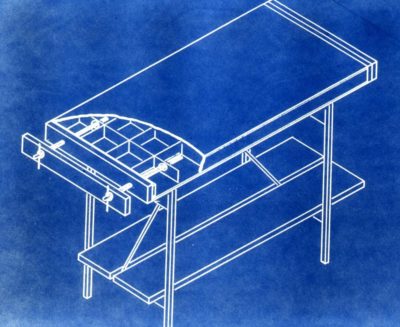
The entire concept rests on the twin features of an ultra-high slab strength and ultra-low slab weight. The only obvious resolution of this seeming paradox was to fashion the slab in the form of a torsion box, a concept I first learned from Ian Kirby. My historical trek is as follows.
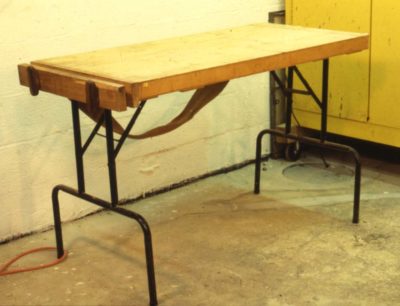
Version 1.0 was really just a proof-of-concept prototype, although it is still in use more than twenty years later, albeit as a table next to the barbecue grill. The 24″ x 48″ top was indeed lightweight and very strong, but that was countermanded by using folding steel legs heavier than the top.
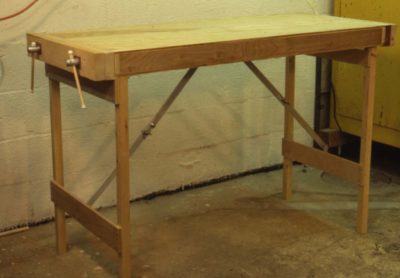
Version 2.0 was a marked improvement in many respects, and is still in use on the fourth floor as a work table. The top dimensions remained at 24″ x 48″.

Version 3.0 was a demo project from a Groopshop eight(?) years ago for/with my friend BillR, who needed a bench to use in a museum gallery, which happened to be identical to the original purpose concept for the bench project. Make a large, strong, lightweight collapsible bench that one man could easily carry into a work environment, set it up and take it down. One of the major changes to this version was to make the top 24″ x 60″ which increased the overall weight around 4 pounds but added some important improvements to the undercarriage layout and construction.
Version 4.0 builds on the earlier improvement and takes the bench many steps farther.
Stay tuned.
Last weekend I hosted another Historic Finishing worship at the barn, an event commissioned by a group of guys who met at a woodworking class somewhere. Given the general level of disinterest in folks attending classes here I will no longer be scheduling any workshops other than ones that are commissioned. I am truly not complaining, just recognizing reality for what it is. As CS Lewis commented, “Reality is a ruthless instructor, it does not care if you agree with it or not.”
It took a long time to get the classroom cleaned out, prepped, and outfitted with a range of tools and exercises for the students. I’ll recount the experience over the next few days. It was a marvelous time, but since it was all about shellac and beeswax, how could it not be?
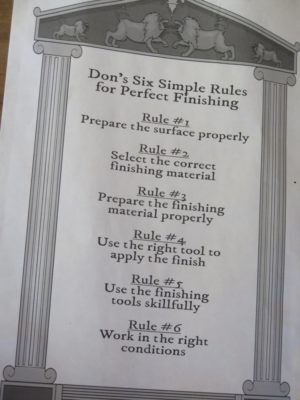
As always we will begin with a discussion of the Six Rules, handing ledger sized printouts for each to take home and guide their work the remainder of their lives.

I have distilled and refined the curriculum over the years into a dozen exercises, and think it is just about the max I can cram into 2-1/2 days. I suppose I should write this up some day in a syllabus format.
Stay tuned.
With the Romastonian Low Bench up and working a little bit, mostly because I have just been too busy with other activities lately to give it a solid and lengthy workout, I identified one last feature to incorporate into/onto the bench.
While planing the edge of a board wedged into the crochet I was setting the board’s weight on my Japanese tool box that resides under the bench. It worked well enough. Like most of you I employ a standing dead-man when using my other benches but that did not seem to work so well here and if I move the tool box elsewhere I need a different utility.

Instead I envisioned some rotating tabs tucked under the edge of the bench, out of the way whenever I am not edge planing, perfectly suitable when turned out as needed. As you can see clearly this was exquisitely elegant craftsmanship. A scrap of 1×2 chopped into five pieces, then affixed to the underside of the bench edge with decking screws and fender washers. I am certain that if Roubo had owned a battery drill, decking screws, and fender washers this is the exact way he would have solved this problem.
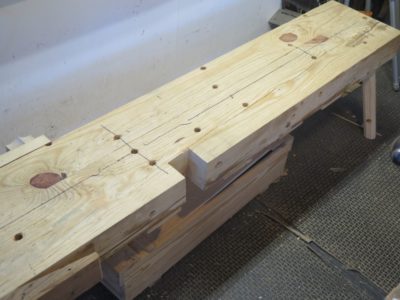

While upstanding for “normal” use the new utility is imperceptible. When readied for combat the knee busters come out.
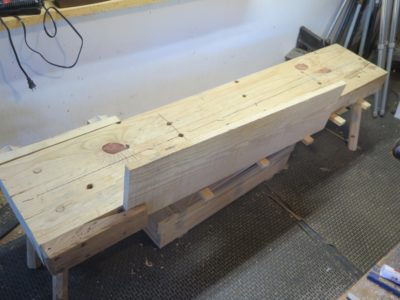
And in the heat of battle they do their task perfectly. I’m thinking I might decide to scoot the crochet a few inches in from the end to better fit my own posture when working while seated.
About the only thing left for the bench is to wait through a winter in the heated space (with its attendant reduction in RH) I’ll true the top then tooth it in keeping with my preferences. I am very much pleased with the bench and expect it to become a workhorse in the shop.
Is it my final workbench project? Don’t be silly. I’ve got three more already in various stages of development and fabrication, each of them profoundly different than the others. Besides, since I just learned I am going to be a grandpa I’ve gotta be ready with whatever bench Barngrandbaby #1 would like. Working on that first tool kit already…
One of the aspects of having a humungous Fortress of Solitude like the barn, four stories of 40′ x 36′ space, is that there are a multitude of nooks and crannies into which things can be tucked, stuffed, crammed, lost, and re-discovered. I call these instances my own “Clean Up Christmases,” when I come across treasures I had forgotten, or at least misremembered.
Such has been the case recently when prepping the classroom for this coming weekend workshop Historical Wood Finishing. As the first class there in over two years, the space had, shall we say, devolved. That pesky Second Law of Thermodynamics; they tried repealing it but it just didn’t take. It has taken me over two weeks to get it ready for the group on Saturday. The level of “rearrangeritis” (full credit to James “Stumpy Nubs” Hamilton for coining the phrase to describe an all-day travail when moving one thing in his crowded shop) has been monumental, and monumentally rewarding on several fronts. It has also given me time for contemplation about future projects, a topic I will address in numerous upcoming posts.

At the moment I am mostly reveling the rediscovery of two caches that were set aside for some future completion. The first is the two sets of brass Roubo-esque squares fabricated before and during that workshop more than two years ago; all it will take is a day or two with some files and Chris Vesper’s sublime reference square to get them up and running.
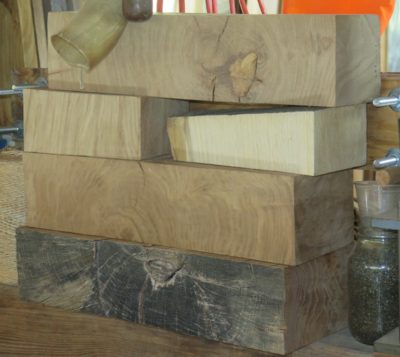
A second trove is the pile of French oak scraps from the multiple iterations of the FORP gatherings in southern Georgia. I brought them home in order to turn them into veneers, probably oyster shell style, to use on some as-yet-unknown project. That “unknown” identifier is becoming more “known” as the days go by. Then, much like my shop being the only one in the county with two c. 1680 parquetry flooring panels from the Palais Royale in Paris, my tool cabinet will be the only one with veneers from some c.1775 oak trees from the forests surrounding Versailles.
Who knows what other “Christmas” presents I might find during the never ending effort to impose order on my space? Stay tuned.














Recent Comments